Classic Studies on Eschatology (27 vols.)
Digital Logos Edition
Learn even more about eschatology by taking Mobile Ed: TH341 Perspectives on Eschatology: Five Views on the Millennium (4 hour course).
Overview
The Classic Studies on Eschatology collection presents many of the defining late-nineteenth and early-twentieth-century studies on the biblical doctrines concerning the end times. Thanks to such notable authors as W. O. E. Oesterley, R. H. Charles, William Kelly, and Alvah Hovey, Classic Studies on Eschatology interprets, translates, and contextualizes important doctrines such as immortality, the second coming of Christ, the millennium, the kingdom of God, and more. The collection’s 27 volumes and nearly 9,000 pages have had an enduring impact on our understanding of the future state of man and the world. This exceptional library provides easy access to a wealth of significant scholarship.
This collection is essential for students, scholars, pastors, historians, teachers of the Bible, and anyone else studying eschatology. With Logos Bible Software, these volumes are completely searchable—Scripture passages appear on mouseover and link to your Greek and Hebrew texts and English translations. For scholarly work or personal Bible study, this makes these volumes more powerful and easier to access than ever before. With Logos’ advanced features, you can perform comprehensive searches by topic or Scripture reference—finding, for example, every mention of “resurrection,” or “1 Peter 4:7.”

- In-depth studies on eschatology
- Notable authors from a variety of backgrounds
- Completely searchable content linked to your favorite Bible translation and your other books
- Title: Classic Studies on Eschatology
- Volumes: 27
- Pages: 8,724
This title is included in the following collections
You can save when you purchase this product as part of a collection.
Logos 6 Collector's Edition Le...
$11,399.99$11,399.99
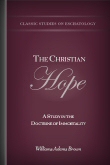
In this study of the doctrine of immortality, William Adams Brown frames his discussion around “hope” as it is expressed in faith of a personal immortality. He defines the nature of the hope, explains its origins and antecedents, traces its history, and shows its relation to other forms of hope which have preceded or accompanied it. He considers the different forms the hope has assumed at different periods in its history as well as the reasons many have abandoned this hope in modern times, as well as the substitutes which have been proposed to replace it. Finally, he considers the grounds on which it rests, the need which it answers, and the reasons for believing that it is still a hope for a sensible person to cherish as an assured conviction.
Its thought and language are intelligible to the layman; its wide and accurate knowledge of the sources, impartial spirit, and lucid exposition are a pleasure to the scholar; while its abundant references to available books on particular aspects of the great them incite such as are so inclined to further study.
—Homiletic Review
Dr. Brown’s little volume is written in a clear and attractive style, and shows a wide acquaintance with the literature of the subject.
William Adams Brown (1865–1943) was Roosevelt Professor of Systematic Theology at Union Theological Seminary, New York City. He was ordained in the Presbyterian Church in 1893 and was acting president of Yale University from 1919 to 1920.
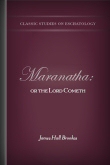
The title of this volume is taken from the 1 Corinthians 16:22. The inspired apostle, after stating that the salutation was given, not by an amanuensis, but with his own hand, adds these words of the most solemn import: “If any man love not the Lord Jesus Christ let him be Anathema Maranatha.” The threatened curse in the fullness of its desolating power may be delayed, but it is sure; for the Anathema is immediately followed by Maranatha, which means The Lord or Our Lord Cometh. It is important to show that Maranatha refers not to a past, but to a future coming of Christ. That His promised coming again occupied the thoughts and engages the affections of the early Christians, and that it is the great event to which Christians now should look with believing and longing contemplation is the object of this volume to show.
James Hall Brookes (1830–1897) was an early proponent of dispensational premillennialism and the pre-tribulation rapture. He was a popular preacher, and began his writing career authoring pamphlets for wounded Civil War soldiers. He was the editor of the monthly magazine The Truth or Testimony for Christ, which had a circulation of more than 40,000, as well as numerous books, including Salvation: The Way Made Plain, Chaff and Wheat: A Defense of Verbal Inspiration, and Did Jesus Rise?
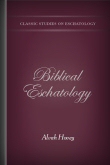
By assuming the divine authority of the Bible as a source of religious truth, the way to just conclusions respecting a future life is by no means easy. In Biblical Eschatology, Alvah Hovey has endeavored to ascertain the meaning of God’s word in relation to eschatology, and to exhibit that meaning as clearly as possible. The topics considered are natural death, the resurrection of the dead, the state between death and resurrection, the last judgment, the final state of believers, and the final state of unbelievers.
While thorough in its scholarship it is devoid of obscuring technicalities, or rather because of a thorough study of its topic, the treatise is so simple and plain as to be read with interest by the layman as well as by the professional investigator. It presents in impressive array the biblical reasons for the doctrines prevailing in evangelical circles.
—Baptist Quarterly Review
Nothing could be more simply or more soundly put.
Alvah Hovey (1820–1903) was born in Greene, New York, and educated at Dartmouth College and Newton Theological Institution. He stayed at Newton as a librarian and professor of Hebrew, church history, theology, and Christian ethics. His numerous books include Commentary on the Gospel of John, The State of the Impenitent Dead, and Commentary on the Epistle to the Galatians.
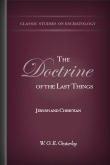
For a right understanding of what the Gospels teach concerning the “last things” it is indispensable that the antecedents upon which that teaching was, in the first instance, based should be studied. Eschatology, like so many other things, went through a process of development before it assumed that form which the Gospels have made so familiar to us. No developed growth can be satisfactorily studied without knowing something about its earlier processes of formation and the conditions under which development took place. And, therefore, if we wish to understand what the Gospels teach concerning the “end of the world,” the first requisite is that we should have some idea of that earlier teaching upon which it is based.
Where is this earlier teaching to be found? Firstly, in the Old Testament; secondly, and chiefly, in the Apocalyptic literature; and thirdly, though in much less degree, in Rabbinical literature, wherein are re-echoed so many of the popular conceptions on this subject. The Doctrine of Last Things provides in-depth insight into what these three classes of literature have to say about the afterlife.
W. O. E. Oesterley (1866–1950) was educated at Brighton College, Jesus College, and West Theological College. Oesterley went on to become Professor of Hebrew and Old Testament Studies at King's College, London. He is the author of numerous titles, including: The Wisdom of Jesus the Son of Sirach or Ecclesiasticus, The Epistle to Philemon, and An Introduction to the Books of the Apocrypha.
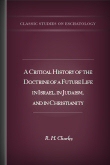
The purpose of this work is to deal with the Hebrew, Jewish, and Christian eschatology, or the teaching of the Old Testament, of Judaism, and of the New Testament on the final condition of man and of the world. Charles traces the development and historical context of the future life doctrine from the time of Moses to the close of the New Testament. He examines the eschatology of the individual and the nation in the Old Testament, the eschatology of apocryphal and apocalyptic literature of first and second century BC and first and second century AD, the eschatology of the New Testament, and the Pauline eschatology in its four stages.
R. H. Charles (1865–1943) is recognized as one of the leading figures in Enoch scholarship, and his masterly translation remains the standard edition of the text in English. An authority on apocalyptic literature, he became canon at Westminster Abbey in 1913 and an archdeacon in 1919. Charles is also the author of A Critical and Exegetical Commentary on the Revelation of St. John, vols. 1 and 2, and The Apocrypha and Pseudepigrapha of the Old Testament.
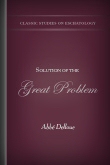
In Solution of the Great Problem, Abbé Delloue defines the “great problem” to be the fate of the soul’s existence after death. He then outlines various solutions that have been provided throughout history, particularly by materialism and pantheism. He then provides the Christian argument for God, dividing the argument into three parts: popular, scientific, and philosophical. From there, Delloue sets the stage for the Catholic teaching of the doctrine of immortality.
The existence of a personal and infinite God, and the immortality of the soul are truths of such fundamental importance, that the author has done well in devoting over a third of his work to their consideration and proof.
—America
Abbé Delloue was educated at the Polytechnique, France, and served as a military chaplain at Soissons.
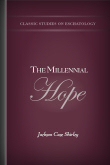
The primary purpose of this book is to answer a single important question: are the ills of society to be righted by an early and sudden destruction of the present world, or is permanent relief to be secured only by the gradual process of strenuous endeavor covering a long period of years. A treatise against premillennialism, Shirley Jackson Case’s The Millennial Hope is designed to exhibit “the fallacious and harmful character of teachings regarding the imminent end of the world.” Case examines the Egyptian, Babylonian, Persian, Greek, and Roman views as to the final destiny of the world, then examines early Christian and later Christian beliefs.
Professor Case has made an exhaustive study of the various beliefs in a sudden ending of the world.
—Yale Review
In that lucid and vivid style which is the result of a complete mastery of the facts combined with true historical intuition, the author gives us a brief review of all the most cherished metaphysical aspirations of the race that may be said to have ultimately contributed to the formation of Christian doctrines.
—Open Court
Shirley Jackson Case (1872–1947) was professor of Early Church history and New Testament interpretation at the University of Chicago.
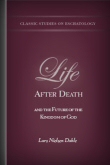
In Life after Death, Dahle provides a survey of the main features of the biblical doctrine of “the last things.” He has divided his treatise into three areas of study:
- The future of the individual, from and including death, until Christ’s final advent
- The future of God’s kingdom on earth until Christ’s final advent
- The Lord’s final advent and its results to the individual, to the Church universal, and to the whole creation
We have no doubt that Lutherans will regard Life after Death as an acceptable addition to their theological literature.
—Dublin Review
Remarkable in its originality and grasp.
—Homiletic Review
Bishop Dahle is no dry-as-dust theologian; his heart is in the matter, and he writes in a vivid and direct style which does not lose its attractiveness even in its new dress. It is the homilist that speaks as well as the theologian, when at the very outset the doctrines of ‘the last things’ are presented as the doctrine of hope. We are charmed everywhere with the geniality of his presentation and his careful separation of what is deemed certain from that for which nothing more than probability is claimed, and we are not only instructed but elevated by every page.
Lars Nielsen Dahle (1843–1925) was a Norwegian Lutheran missionary educated at the University of Oslo and the School of Mission and Theology, Norway. He is the author of African Folklore and Why Do We Mission?
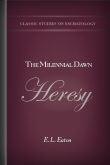
In this short and succinct volume, E. L. Eaton challenges the interpretive and eschatological views held by Charles Taze Russell, founder of the late nineteenth-century Bible Student Movement—precursor to the Jehovah’s Witnesses. In the autumn of 1903, the two pastors held public debates, and after many requests, Eaton edited and published his views on the “Millennial Dawn heresy.” He divides his argument into five parts: principles of biblical interpretation, immortality and soul-sleeping, the present gospel age, the millennium, and probation after death. This is one of the most significant works responding directly to Charles Taze Russell’s eschatological and millennialist views.
This pithy little treatise of 153 pages challenges every doctrine and assails every distinctive feature of the Millennial Dawn theory. It plainly shows how untrue it is and how out of harmony with the Word of God.
—Christian Advocate
Ephraim Llewellyn Eaton (1846–1931) was pastor of the North Avenue Methodist Episcopal Church in Pittsburgh, Pennsylvania. His other works include The Science of Mental Healing and Winning the Fight against Drink.
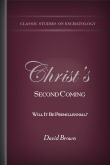
In Christ’s Second Coming: Will It Be Premillennial?, Brown defines premillennialism as a theory that advocates that Christ will soon come, not to carry on in person and in power the work of converting and saving men—his kingdom of grace—but to close the dispensation of grace altogether, and to introduce an eternal state of retribution. Instead, Brown advocates the theory that there will be, before Christ’s coming, a long period—an estimated thousand years—when the Gospel will have general prevalence and power among men, and grace will be victorious over the whole earth. He divides his study into three parts: “The Second Advent,” “The Millennium,” and “Objections.”
This is an able and timely work.
—Yale Review
David Brown (1803–1897) was professor of theology at Free Church College in the University of Aberdeen. He served as director of the National Bible Society of Scotland, the Evangelical Alliance, and the Alliance of the Reformed Churches. His works include The Restoration of the Jews, The Apocalypse, and Crushed Hopes Crowned in Death.
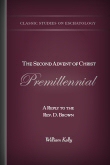
The Second Advent of Christ Premillennial is a spirited reply to David Brown’s Christ’s Second Coming and a staunch defense of premillennialism. Kelly covers the relation of Christ’s coming again to the question of time, the nature of the millennium, the millennial co-existence of earthly and heavenly things, the millennial binding of Satan, and much more.
William Kelly (1823–1906), born in Ireland, moved to London after attending Trinity College in Dublin. Highly involved with the Plymouth Brethren, he served as editor for The Collected Writings of John Nelson Darby and published numerous works.
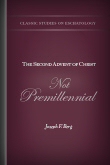
The Second Advent of Jesus Christ Not Premillennial consists of a course of lectures delivered in 1859 to the congregation of Joseph F. Berg’s church, the Second Reformed Protestant Dutch Church of Philadelphia. In the introduction, he states that his objection to the doctrine of the personal reign of Christ and to the premillennial advent is based on “the inconsistency which that theory involves with the established truths of the Gospel.” Berg begins his study of the second coming with an examination of Acts 1:11, broadening his argument over eleven thoughtful discourses.
The doctrine of the Second Advent, in its various bearings and relations, is vigorously and ably handled in this volume. The main arguments against the premillennial hypothesis are presented with earnestness and conclusiveness. Dr. Berg has the power of seeing and stating clearly just the strongest points for attack and defense.
—American Presbyterian Review
Joseph F. Berg (1812–1871) was born in Antigua where his father was a Moravian missionary. He was the editor of The Protestant Quarterly and the author of numerous works, including Abaddon, and Mahanaim; or, Daemons and Guardian Angels, The Doctrine of Grace, and Lectures on Romanism.
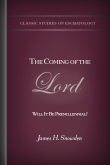
The central point that James H. Snowden’s The Coming of the Lord holds in view and contends for is that the kingdom of God is now being established and will reach its full development in the world under the present ministration of the gospel and agency of the Holy Spirit, and will be followed by the final advent of Christ and the eternal state; and the view it opposes reverses this order and holds that Christ must first come in judgment and power before this work can be achieved.
This volume will especially appeal to the thoughtful pastor who wants to find both information about premillennialism and a fundamental point of view for his own thinking.
—Biblical World
We know of no abler book on the subject than Dr. Snowden’s The Coming of the Lord.
—Union Seminary Review
James H. Snowden (1852–1936) was professor of systematic theology at Western Theological Seminary, Pittsburgh, PA. His numerous works include A Wonderful Morning: An Interpretation of Easter, A Wonderful Night: An Interpretation of Christmas and Can We Believe in Immortality?
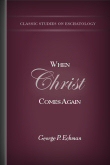
This volume broadly examines the doctrine of the Second Coming of Christ without confining itself to the debate between premillennialists and postmillennialists. Eckman first explores the manner and purpose of the Lord’s return, then devotes a chapter to the time of the return. Eckman answers the questions, What is Christ doing now and What should we be doing until his return? He then focuses on the doctrine of the millennium, explaining where it is found in the Bible and how it has been misinterpreted by many Bible commentators. Written in popular, plain language, When Christ Comes Again is a vital volume for anyone studying second coming theology.
The last part of the volume is devoted to a fair, sober, and Scriptural criticism of what the author calls “the pre-millennial program,” showing very pointedly the difficulties involved in the ideas of “the Rapture,” “the Revelation,” “the Great Tribulation,” the several returns of our Lord, the several judgments, and the two-fold resurrection. Mr. Eckman does this very well. He proves beyond doubt for any unprejudiced reader that these ideas are not only unscriptural but also in direct conflict with the Bible.
Dr. Eckman is blessed with an abundance of good horse sense: his style is concise, clear, direct and simple. Evidently he has made a most thorough study of the whole Bible from Genesis to Revelation, and he gives sound and convincing interpretation of the passages relating to the Second Coming.
—Union Seminary Review
George P. Eckman (1860–1920) was a Methodist Episcopal minister and editor of the Christian Advocate. He was educated at Wyoming Seminary College, Wesleyan University, Drew Theological Seminary, and New York University. Eckman pastored St. Paul’s Methodist Episcopal Church, NY, and Elm Park Church in Scranton, PA. His numerous works include The Literary Primacy of the Bible, The Return of the Redeemer, and Studies in the Gospel of John.
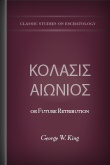
In this study of the doctrine of future retribution, George W. King presents the scriptural view of the doctrine while critiquing various objections against it. He examines the eternity of punishment, the objections of Restorationists, the New Testament terminology respecting future retribution, the nature and necessity of future punishment, the doctrine of annihilation, and much more.
He deals with the question in a masterly way, showing perfect command of his material and a becoming sense of the gravity of the doctrine with which he deals.
—London Quarterly Review
An able discussion of the doctrine of eternal punishment.
—Reformed Quarterly Review
The thoroughness of its discussion, as well as the clearness of its style, will make the book at once instructive and readable.
—Henry Anson Buttz, President, Drew Theological Seminary
I have read Future Retribution with great delight and satisfaction. The ground is covered admirably and leaves little, if anything, to be desired on this most important and practical part of the discussion.
George W. King was pastor of the Broadway Methodist Episcopal Church in Providence, RI.
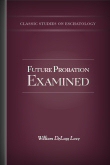
It is the chief design of this work to examine the theory of probation after death by the light of Scripture and of the pertinent religious literature before and after Christ. By examining the literature next to Scripture, we can get a kaleidoscope view of Scripture instruction. William DeLoss Love quotes from the Targums, Josephus, Clement of Rome, Ignatius, Tertullian, Origen, Lactantius, and from Scripture. He compares the orthodox doctrine of one probation with the doctrines of annihilation, soul-sleeping, and prayer for the dead.
Dr. Love has rendered a needed service to the Christian ministry by compiling, in brief form, the opinions of many writers, some of whom preceded and others succeeded, by centuries of time, the days of Christ, concerning the new dogma of future probation.
—Methodist Review
William DeLoss Love (1819–1898) was educated at Genesee Wesleyan Seminary, Hamilton College, Andover Theological Seminary, and Yale Theological Seminary. Ordained in 1871, he was an active abolitionist, a prolific writer, and editor of the Wisconsin Puritan. His books include Samson Occom and the Christian Indians of New England, The Reopening of the African Slave Trade, and Christ Preaching to the Spirits in Prison.
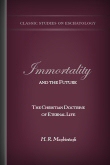
Immortality and the Future is a solid survey of the ideas of a future life and of the biblical teachings on immortality, leading up to the Christian view. It is meant as a first guide to those who are studying the problems of eschatology, and who wish to do so in the full light of history and faith. H. R. Mackintosh divides his study into two parts. The first traces the historical development of the doctrine through differing faiths, Judaism, and in the teachings of Jesus, the apostles, and the church. The second part is a reconstructive statement of the doctrine in the light of scholarship from various Christian sources.
H. R. Mackintosh (1870–1936) was a professor of divinity at New College, Edinburgh, from 1904 to 1936. He was a close friend of P. T. Forsyth, and the two held simliar views of the kenotic doctrine of the incarnation. His works include The Doctrine of the Person of Jesus Christ and Christian Experience of Forgiveness.
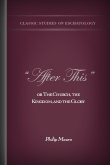
The leading feature of God’s great work for this age is the introduction into the world of “the Kingdom of heaven,” which is the prominent subject of the New Testament. Therefore it is absolutely essential to a right understanding of this present age, and its place in God’s vast plan, to know with certainty what the Kingdom of heaven is, where it is, and when; to know its beginning and ending, and who are in it and who are without.
Philip Mauro (1859–1952) was a member of the bar of the Supreme Court of the United States and one of the foremost patent lawyers of his day. His numerous works include God’s Pilgrims, Things Which Soon Must Come to Pass, and The Wonders of Bible Chronology.
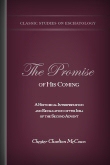
Two ideas are explored in The Promise of His Coming. First, the obscure origin and the slow and uncertain development of the Hebrew, Jewish, and Christian hope of a better world have been set forth. The sources of certain particular phases of the premillennial and postmillennial views have been indicated. This historical survey secures the proper basis for the second idea explored, the attempt to indicate and reinterpret the fundamental social and religious values of the Christian hope of the second coming of Christ.
After a brief exhibition of the nature of the eschatological problem of today, the author devotes the larger part of the book to a critical history of apocalypticism and concludes with a positive, constructive discussion of the content of truth in the idea of the Second Advent.
—Methodist Review
Chester Charlton McCown was professor of New Testament literature in the Pacific School of Religion in Berkeley, CA.
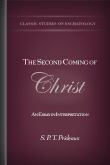
The difficulties of the apocalyptic element in the Gospels have long been a sore puzzle to many. In The Second Coming of Christ, Prideaux seeks to lead readers to perceive that the Kingship of Christ is an actual present fact and power, as well as a hope yet to be realized; and, even more, that they will understand that this power is conveyed through the Holy Spirit. Prideaux surveys other apocalyptic literature and provides parallels which that literature offers to the predictions of the Second Coming in the Gospels.
Sherburne Povah Tregelles Prideaux (1880–1956) was the author of numerous works, including The Cradle of Christianity, Man and His Religion, Thirty-Six Outline Sermons on General subjects, and The Cross of Unity: Addresses on the Seven Words from the Cross.
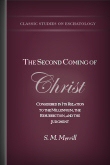
The theme of this volume has occupied more or less of the thought of the Church ever since the Savior ascended to heaven, and will receive attention till he returns. Merrill begins his study of eschatology by examining the various popular theories regarding the Second Coming. He then covers the destruction of Jerusalem and the end of the world, the tribulation, the restoration of the Jews, the Millennium, various theories of the resurrection, judgment after death, and more. Instructive and informative, Merrill addresses these topics with clarity and nontechnical language.
One of Bishop Merrill’s tracts for the times, re-asserting and maintaining the Catholic doctrine of the Church in regard to the future judgment, and well adapted for popular reading.
—Methodist Review
S. M. Merrill (1825–1905) was an American bishop of the Methodist Episcopal Church and an editor of the Western Christian Advocate. His works include A Digest of Methodist Law, Doctrinal Aspects of Christian Experience, and The New Testament Idea of Hell.
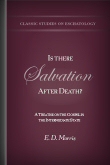
The aim of this treatise is to discuss, mainly in its more obvious and vital aspects, the important question here propounded: is there salvation after death? E. D. Morris seeks to answer this question from the testimonies of Scripture, the witness of Christian symbolism, the evidences drawn from Christian theology, and the testimony of religious experience. In other words, what is proposed in this volume is a solution, practical rather than speculative, of whether what we term the Gospel has any place or mission in the Intermediate State.
An able, frank, and manly discussion of the question, whether there is any reason to expect or believe that the offer of the gospel will be made in the next world to those to whom it is not made in this.
—Yale Review
Its style is precise, vigorous, dignified, and clear. The scheme of the work is comprehensive, omitting nothing material to the question discussed, and it is skillfully wrought out.
—Methodist Review
E. D. Morris (1825–1943) was educated at Yale University and Auburn Seminary Review. He was appointed as professor of church history and of theology in Lane Theological Seminary, Cincinnati. His works include Ecclesiology, Outlines in Christian Doctrine, and Theology of the Westminster Symbols.
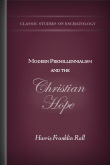
Modern Premillennialism and the Christian Hope contains an in-depth analysis and sharp critique of premillennialism. The first part is devoted to a historical sketch of the development of the hope of a better world from the time of the prophets onward. The second part contains Rall’s critique of premillennialism. Rall provides a bibliography for further research as well as the essay “Was John Wesley a Premillennialist?” in the Appendix.
Harris Franklin Rall (1870–1964) was Henry White Warren Professor of Practical Theology at the Iliff School of Theology, and served as president there from 1910 to 1915. He later taught theology and served as president at Garrett Biblical Institute. His works include The Life of Jesus, The Teachings of Jesus, and A Working Faith.
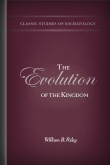
William B. Riley begins his study of the Kingdom of God by explaining its definition, evolution, location, and its citizenship. His exploration of the Kingdom then examines the return of Christ, the rapture, the tribulation, the resurrected body, the biblical order of the Millennial events, and much more.
William B. Riley (1861–1947) founded the Northwestern Bible Training School and served as pastor of the First Baptist Church of Minneapolis, Minnesota, for over 40 years. He was the editor of The Christian Fundamentalist from 1891 to 1933, and his works include The Menace of Modernism, Revival Sermons: Essentials in Effective Evangelism, and Conservative Call to Arms.
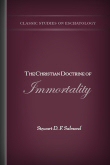
The Christian Doctrine of Immortality is divided into six parts—expansions of six lectures originally delivered in Edinburgh as part of the Cunningham Lectures series. As Salmond states in the introduction, “The present inquiry limits itself to the question, What is the witness of Scripture on the subject? The words of Christ are to me the highest authority, beyond which I seek no other.” Lectures include:
- The Ethnic Preparation
- The Old Testament Preparation
- Christ’s Teaching
- The General Apostolic Doctrine
- The Pauline Doctrine
- Conclusions
As it now stands, the volume is by far the most elaborate and valuable treatise that has yet appeared on the vital doctrine which it so fully and convincingly presents. The Christian Church owes Prof. Salmond an incalculable debt for such a discussion of such a theme.
—Presbyterian and Reformed Review
Stewart Dingwall Fordyce Salmond (1838–1905) was a professor of theology at Aberdeen Free Church College. His works include St. Mark: Introduction, Ulrich Zwingli, and The Epistle to the Ephesians.
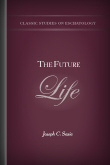
Has God revealed the doctrine of a future retribution? Of everlasting reward to the just, and of eternal punishment to the wicked? Joseph C. Sasia’s The Future Life asks these questions, and then sets out to answer them. He divides his study of the future life into 11 sections:
- The End of Man
- The Sanction of God’s Laws
- The Immortality of Man’s Soul
- The Remunerative Sanction
- How Almighty God Helps Man to Reach His Last Happy End
- The Punitive Sanction
- The Eternity of Hell
- Objections against Eternal Punishment and Their Solutions
- Remarks or Principles Intended to Facilitate the Solution of Difficulties against Eternal Punishment
- Affirmative and Negative Testimonies of Protestant Sects and Their Ministers on the Eternal Punitive Retribution
- Retrospect and Bibliography
The best part of the book, to our mind, is the treatise on hell and its answers to unbelievers who deem the Catholic teaching incompatible with the mercy of an all-loving God.
—Boston Transcript
Joseph C. Sasia works include The Divinity of Jesus Christ and His Virgin Birth, The True View of the Present Persecution in France, and The Inquisition.
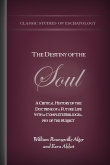
The Destiny of the Soul is divided into five parts. In the first, Alger provides a general outline of the theories that have been maintained as to the general origin and destiny of the soul, the significance of death, and the nature of the future life. The second is a history of the various forms which the afterlife has assumed in the belief and mythology of all non-Christian nations, including the Hebrews. The third part gives a detailed analysis of the essential doctrines on the subject that are found in the New Testament. The fourth part is a synopsis of the patristic, medieval, and modern doctrines of the afterlife. The last part discusses several secondary phases of belief and minor dogmas of the doctrine of immortality. The Appendix of the volume, compiled and written by Ezra Abbot, is a catalogue of works relating to the “Nature, Origin, and Destiny of the Soul.” The bibliography is over 300 pages and the titles are chronologically arranged and contain notes along with indexes of authors, titles, and subjects.
William Rounseville Alger (1822–1905) was educated at Harvard Divinity School from 1844 to 1847. He was an active abolitionist and poet. His works include History of the Cross of Christ, The Solitudes of Nature and of Man, and The Poetry of the East.
Ezra Abbot (1819–1884) graduated with his MA from Bowdoin College in 1843. For 15 years Abbot worked as an assistant librarian for Harvard College. In 1871 he was named as a lecturer of New Testament textual criticism and from 1872 until his death he was Bussey Professor of New Testament Criticism and Interpretation at Harvard Divinity School. He was the author of The Authorship of the Fourth Gospel: External Evidences.
Reviews
18 ratings
Dr. J. T. Carlock
12/18/2021
joe_bourne1951@hotmail.com
4/2/2019

Kevin Bratcher
6/12/2018

M. David Johnson
3/27/2015
RichThay47
11/11/2014
Derek Anderson
11/11/2014

Pedro J Martinez
10/29/2014
AeliusCicero
6/19/2014

Fernando Canale
3/12/2014